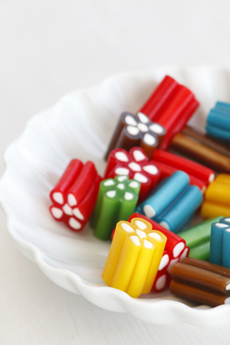FOOD HOLIDAY: National Licorice Day & Licorice History
|
April 12th is National Licorice Day. We’ll let others debate the merits of Red Vines versus Twizzlers; our heart belongs to Australian licorice, which is spelled liquorice there and in other parts of the former British Empire. In 2011, the last year for which we could find figures, U.S. licorice sales topped $359 million, a 6.56% increase over the prior year and proof that not everyone is dying for chocolate (the non-chocolate candy market had total sales of $6.87 billion). Licorice extract is made from the root of the licorice plant, Glycyrrhiza glabra. It derives its botanical name from Greek words meaning “sweet root.” The sap of the root is 50 times sweeter than sugar! A member of the pea family that is native to southeastern Europe, licorice grows about four feet high. Its pretty bluish purple and white flowers that resemble sweet pea blossoms. Although they have similar flavor notes, licorice is not related to the spices anise and star anise, the vegetable fennel or the spice tarragon. The relation is that all of these plants and spices contain anethole, an aromatic and sweet-tasting ether compound. |
 Licorice “shooters” from Kookaburra, one of our favorites. Photo by Katharine Pollak | THE NIBBLE. |
|
|
Our favorite licorice: Kookaburra, from Australia. You can buy it online. We love all the varieties, but especially the Allsorts (assorted licorice). LICORCE HISTORY We know licorice as moderately firm, semi-firm gelled candy. But for thousands of years in ancient China, Egypt and Greece, it was a cure for stomach and respiratory ills, as well as a thirst remedy for travelers and soldiers. It soothes irritated membranes and loosens congestion in the upper respiratory tract. It helps as an anti-inflammatory effects, with allergies and with the liver. Medicinal use of licorice has been documented for 3,000 years. Ancient Egyptians created a drink from it (a popular version of the drink, called mai sus, is still enjoyed in Egypt). Large quantities of licorice root were found in the tomb of King Tut (1356 to 1339 B.C.E.) The troops of Alexander the Great and the Roman legions used licorice. The Caesars advocated licorice as a health remedy. Some 1800 years later, Napoleon Bonaparte chewed licorice for his ongoing digestive problems. Over time, his teeth turned black from the concentration of licorice juice. You can chew on a piece of licorice root if you want the experience, or are headed to a Halloween party. |
||